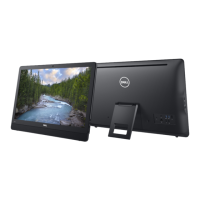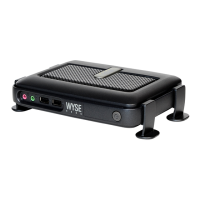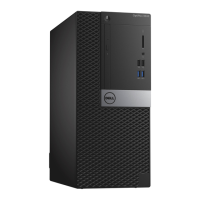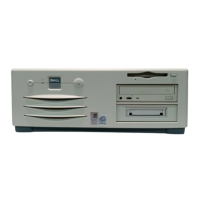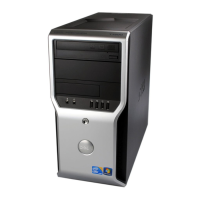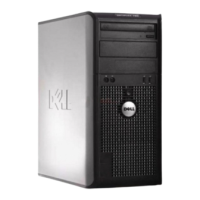Do you have a question about the Dell Wyse 3040 Thin Client and is the answer not in the manual?
Overview of the guide's purpose and scope for Wyse 3040 thin clients.
Links to Dell's support sites for technology-related information and self-service.
Instructions on how to log on to the thin client and understand desktop configurations.
Steps to configure dual monitor setups for optimal display on ThinOS.
Setting up basic network parameters like DNS, domain, and default gateway.
Customizing DHCP options for network configuration.
Details on configuring Ethernet network settings for the thin client.
Steps to set up and manage wireless network connections.
Adjusting keyboard layout, repeat delay, and repeat rate for user preference.
Customizing mouse pointer speed, button configuration, and double-click settings.
Setting up and configuring USB cameras, including resolution and frame rate.
Steps to connect and configure local or network printers.
Guide to accessing and modifying UEFI BIOS settings on the thin client.
Instructions for initial login and accessing admin mode in ThinLinux.
Steps to customize display settings, including resolution and rotation in ThinLinux.
Detailed steps for connecting to wireless networks and managing Wi-Fi connections.
Setting up and securing wired Ethernet connections using various authentication methods.
Steps to add and configure VPN network connections.
Setting up network bonding for increased throughput and redundancy.
Steps to create and configure a network bridge connection.
Adding and configuring Virtual LAN (VLAN) network connections.
Customizing keyboard layout and repeat behavior for user input.
Adjusting mouse pointer speed and button configuration.
Adding and managing printers for the ThinLinux system.
Adjusting audio output and input levels and selecting audio devices.
Creating and managing local Citrix connections, including server details and connection types.
Setting up and managing VMware View client connections with login and experience options.
Understanding system power states and the behavior of power and activity LEDs.
Interpreting power LED status codes for diagnosing hardware issues.
Mapping LED flash patterns to specific hardware faults and troubleshooting actions.
Overview of the guide's purpose and scope for Wyse 3040 thin clients.
Links to Dell's support sites for technology-related information and self-service.
Instructions on how to log on to the thin client and understand desktop configurations.
Steps to configure dual monitor setups for optimal display on ThinOS.
Setting up basic network parameters like DNS, domain, and default gateway.
Customizing DHCP options for network configuration.
Details on configuring Ethernet network settings for the thin client.
Steps to set up and manage wireless network connections.
Adjusting keyboard layout, repeat delay, and repeat rate for user preference.
Customizing mouse pointer speed, button configuration, and double-click settings.
Setting up and configuring USB cameras, including resolution and frame rate.
Steps to connect and configure local or network printers.
Guide to accessing and modifying UEFI BIOS settings on the thin client.
Instructions for initial login and accessing admin mode in ThinLinux.
Steps to customize display settings, including resolution and rotation in ThinLinux.
Detailed steps for connecting to wireless networks and managing Wi-Fi connections.
Setting up and securing wired Ethernet connections using various authentication methods.
Steps to add and configure VPN network connections.
Setting up network bonding for increased throughput and redundancy.
Steps to create and configure a network bridge connection.
Adding and configuring Virtual LAN (VLAN) network connections.
Customizing keyboard layout and repeat behavior for user input.
Adjusting mouse pointer speed and button configuration.
Adding and managing printers for the ThinLinux system.
Adjusting audio output and input levels and selecting audio devices.
Creating and managing local Citrix connections, including server details and connection types.
Setting up and managing VMware View client connections with login and experience options.
Understanding system power states and the behavior of power and activity LEDs.
Interpreting power LED status codes for diagnosing hardware issues.
Mapping LED flash patterns to specific hardware faults and troubleshooting actions.
| Processor | Intel Atom x5-Z8350 |
|---|---|
| Processor Cores | 4 |
| Storage | 8GB or 16GB eMMC |
| Graphics | Intel HD Graphics |
| Operating System | Wyse ThinOS, Wyse ThinLinux, or Windows 10 IoT Enterprise |
| CPU Frequency | 1.44 GHz (up to 1.92 GHz) |
| RAM | 2GB DDR3L |
| USB Ports | 4 (2x USB 3.0, 2x USB 2.0) |
| Network | Gigabit Ethernet |
| Wireless | 802.11ac |
| Bluetooth | Bluetooth 4.1 |
| Ports (Front) | 1 x USB 3.0, 1 x USB 2.0, 1 x Audio Jack |
| Audio | 3.5mm audio jack |
| Weight | 0.24 kg |
| Ports (Rear) | 2x USB 2.0, 1x RJ45, 1x DisplayPort |
